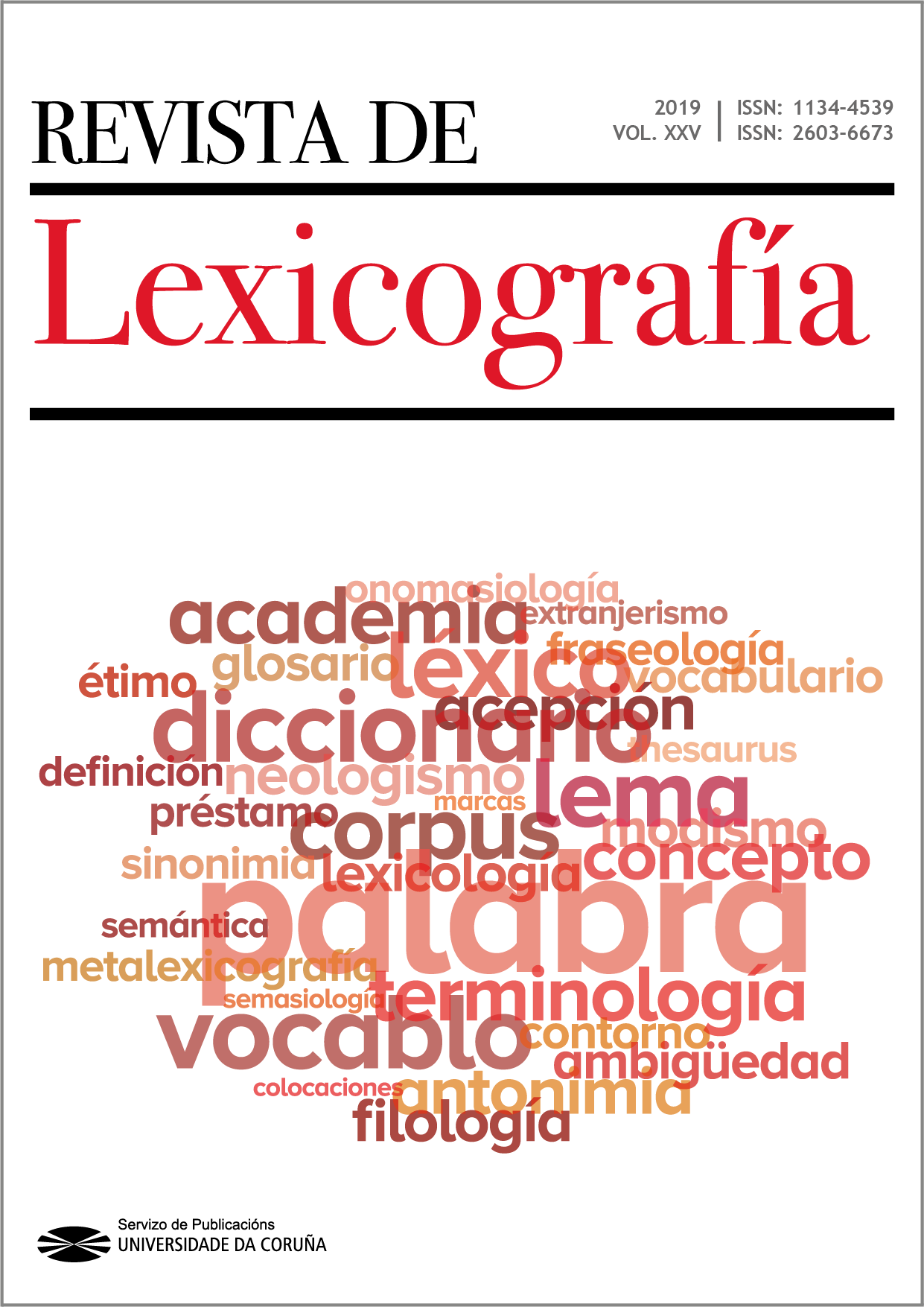Palabras funcionales en diccionarios históricos y el caso del adverbio pronominal hy del castellano temprano
DOI:
https://doi.org/10.17979/rlex.2019.25.0.5739Palabras clave:
palabras funcionales, diccionarios históricos, adverbio pronominal, hy, castellano medievalResumen
El presente trabajo aborda el tema de categorías funcionales en diccionarios históricos y la necesidad de un trabajo en conjunto de la labor lexicográfica y la lingüística teórica e histórica para su óptima cobertura. Se propone que los diccionarios históricos hasta ahora disponibles no cumplen con el cometido de la labor lexicográfica en castellano en el ámbito de categorías funcionales y en la caracterización de su desarrollo histórico. Como ejemplo se enuncian cuatro diferentes acepciones del desparecido adverbio pronominal hy del castellano temprano que generalmente no son cubiertos en los diccionarios históricos hasta ahora disponibles. Por lo tanto, proponemos que dicha empresa requiere de una aproximación lexicográfica que incorpore la distribución diacrónica de palabras funcionales junto con sus respectivos valores pragmático-contextuales.
Descargas
Referencias
Alonso, Martín (1986): Diccionario medieval del español, Salamanca, Universidad Pontificia de Salamanca.
Álvarez de Miranda, Pedro (2006): «Problemas y estado actual de los estudios sobre historia del léxico español», en José Jesús de Bustos Tovar y José Luis Girón Alconchel, eds., Actas del VI Congreso Internacional de Historia de la Lengua Española, Madrid, Arco/Libros, pp. 1229-1239.
Joseph, Brian D. (2001): «Is there such a thing as “grammaticalization”?», Language Sciences, 23, 2-3, pp. 163-186 [special issue, Grammaticalization: A Critical Assessment, ed. L. Campbell].
Joseph, Brian D. (2003): «Morphologization from syntax», en Brian D. Joseph y Richard D. Janda, eds., The handbook of historical linguistics, Hoboken, Blackwell, pp. 472-492.
Joseph, Brian D. (2004): «Rescuing traditional (historical) linguistics from grammaticalization theory», en Olga Fischer, Muriel Norde y Harry Perdridon, eds., Up and down the Cline. The nature of grammaticalization, Amsterdam, John Benjamins, pp. 45-71.
Joseph, Brian D. (2006): «How accommodating of change is grammaticalization? The case of “lateral shifts”», Logos and Language, 6, 2, pp. 1-7.
Corominas, Joan y José A. Pascual (1980-1991). Diccionario crítico etimológico castellano hispánico, Madrid, Gredos.
Douvier, Elizabeth (1978): «L’évolution et la disparition de l’adverbe de lieu “y” dans les manuscrits du Libro de la Monteria», Cahiers de linguistique hispanique médiévale, 3, pp. 33-50.
Garcés Gómez, María Pilar (2008): La organización del discurso: marcadores de ordenación y de reformulación, Madrid-Frankfurt, Iberoamericana Vervuert.
Garcés Gómez, María Pilar y Cecilio Garriga (2010): «Las marcas de uso en un diccionario histórico», en M. Gómez Martínez y J. R. Carriazo eds., La marcación en lexicografía histórica, San Millán de la Cogolla, Cilengua, 2010, pp. 171-241.
Garcés Gómez, María Pilar (2011): «El proceso evolutivo de los marcadores de separación», Romanistisches Jahrbuch, 61, pp. 289-313.
Herrera, Mª Teresa (1996): Diccionario español de textos médicos antiguos, Madrid, Arco/Libros.
Hopper, Paul y Elizabeth Traugott, (2003): Grammaticalization, Cambridge, Cambridge University Press.
Kasten, Lloyd A y Florian Cody (20012). Tentative Dictionary of Medieval Spanish, New York, Hispanic Seminary of Medieval Studies.
Kasten, Lloyd A. y John Nitti (2002): Diccionario de la prosa castellana del Rey Alfonso X, New York, Hispanic Seminary of Medieval Studies.
Loureda Lamas, Óscar (2017): «Marcadores del discurso, pragmática experimental y traductología: horizontes para una nueva línea de investigación (I)», Pragmalingüística, 18, pp. 74-107.
Luna, Paul (2004): «Not just a pretty face: the contribution of typography to lexicography», en Geoffrey Williams y Sandra Vessier, eds., Proceedings of the Eleventh EURALEX International Congress, 6-10 July 2004, Lorient, Université de Bretagne Sud, pp. 847-858.
Luna, Paul (2018): Typography: A very short introduction, Oxford, Oxford University Press.
Menéndez Pidal Ramón, Alfonso Reyes y Juan Carlos Conde (2006): Cantar de Mio Cid, Madrid, Espasa Calpe.
Müller, Bodo et al. (2018). Diccionario del español medieval, Heidelberg, C. Winter.
Partee, Barbara (2004): «Weak NP’s in have sentences», en Compositionality in Formal Semantics, Blackwell Publishing Ltd., pp. 282-291.
Polo Cano, Nuria (2006): «Breve aproximación a los adverbios pronominales y y ende en los documentos notariales de la Vizcaya tardomedieval», Eusko Iskakuntza, 21, pp. 377-393.
Tejedo-Herrero, Fernando (2010). Progress towards a historical dictionary of a legal text in Spanish: The Siete Partidas (1256-1265/1491), en John Considine, ed., Current projects in historical lexicography, Newcastle upon Tyne, Cambridge Scholars, pp. 35-60.
Vázquez Diéguez, Ignacio (2015): «La composición lexicográfica de palabras funcionales. El caso de la preposición de a partir del corpus del Diccionario General y Etimológico del Castellano del siglo XV en la Corona de Aragón (DICCA-XV)», Revista de Filología Románica, 3, 1, pp. 75-91.
Vázquez, Luis Fernando (2015): Partiendo de ibi: La traducción del antiguo adverbio pronominal en las primeras Biblias romanceadas castellana e italiana a partir de la Vulgata, Provo (Utah), Brigham Young University [Master's thesis accesible en https://scholarsarchive.byu.edu/etd/5599/].
Wanner, Dieter (2001): «La pérdida del clítico adverbial y en castellano», Lingüística Iberoamericana, 12, pp. 1-28.
Zucchi, Alessandro (1995): «The Ingredients of Definiteness and the Definiteness Effect», Natural Semantics, 3, pp. 33-78.
Corpus y otros sitios utilizados
Enrique-Arias, Andrés, dir. (2008): Biblia Medieval [en línea] http://www.bibliamedieval.es.
Le trésor de la langue Française informaticé (1994): ATILF-CNRS & Université de Lorraine [en línea] http://atilf.atilf.fr/.
Real Academia Española (2013): Nuevo diccionario histórico del español (NDHE) [en línea] http://web.frl.es/DH.
Descargas
Publicado
Número
Sección
Licencia
Los trabajos publicados en esta revista están bajo una licencia Creative Commons Reconocimiento-CompartirIgual 4.0 Internacional.
Los autores ceden el derecho de la primera publicación a la Revista de Lexicografía, la cual podrá publicar en cualquier lengua y soporte, divulgar y distribuir su contenido total o parcial por todos los medios tecnológicamente disponibles y a través de repositorios.
Se permite y anima a los autores a difundir los artículos aceptados para su publicación en los sitios web personales o institucionales, antes y después de su publicación, siempre que se indique claramente que el trabajo pertenece a esta revista y se proporcionen los datos bibliográficos completos junto con el acceso al documento.



